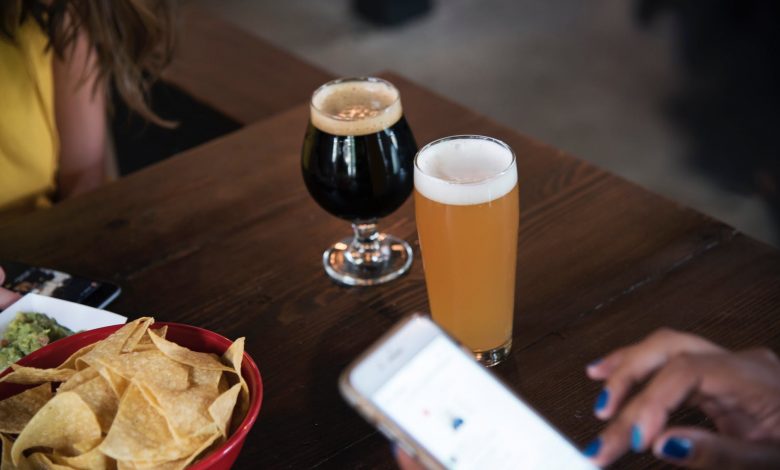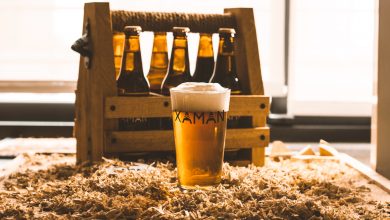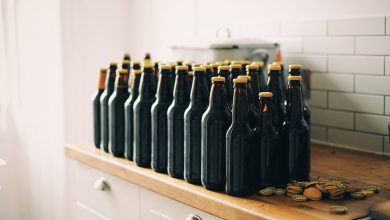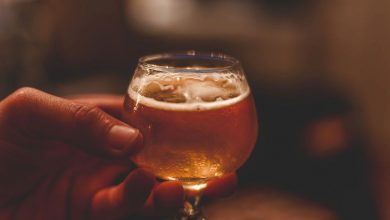Ale vs Lager: The Differences Every Beer Lover Needs To Know

If you are one of those who enjoy a cold sip when hanging out with family and friends, surely you must have faced moments when you were presented with a beer menu so extensive that you were confused about what to pick. Then there is the eternal debate between ale and lager. Are they different from one another, and if so, what are those differences? Let us begin with a short answer to the question and then delve into the deeper, more nuanced aspects of both families of beer.

The Short Beer Story
Right from the middle ages, the process of beer making was pretty hit and miss. Made from malt, the fermentation over time produced both the alcohol and bitter taste. Judging from the civic records and correspondences of the time, a common attribute to the beer being served at inns was its off-putting flavor. A reliable brewer then was more of a unicorn among horses.
With time, differences began to emerge. Ale, the native English word for the bevera,ge employed a mixture of plants and herbs for flavor. Known as ‘gruit,’ every alewife or brewer had their own measurements and choice of ingredients, the knowledge of which stayed within the family.
Beers, on the other hand, were flavored with hops. While the cultivation of hops began in Germany and went as far back as the 8th century, their use in brewing was not seen until the 11th century. Britain got its first taste of hopped beer around 1400, and they adopted the Dutch word ‘bier’ to differentiate it from their local ale. And the two methods of brewing saw fierce competition from one another, with even monarchs getting into the action by imposing a tax on one or the other form of brewing depending on what they preferred.
The concept of lager came later from Bavaria, once the process of fermentation had been perfected. Typically, these alcoholic beverages employed yeasts that begin fermenting from the bottom and move upwards. Also, lager yeasts work best in a temperature range (40 – 55 degrees Fahrenheit).
Regardless of the huge variety of selections available, beer can be broadly categorized into lagers or ales, wherein, the basic difference between them is determined by the yeast that is used, the temperature that is kept and the time that is followed during the process of fermenting the beer.
A few common types of ales are Hefeweizen, Pale Ale, Stout, Barley Wine, Bitters, and Indian Pale Ale; and lagers are Marzen, Bock, Pilsner, Helles, Schwarzbier, and Dunkel. However, if you are a beer lover, you would be keen to understand all these factors that can help you differentiate between an ale and a lager without fail.

The Ingredients
The yeast is the primary ingredient that brings about the difference between the two types of beers. The yeast used for an ale is a top-fermenting one known as ‘Saccharomyces cerevisiae,’ which has been around forever, while the yeast used for the fermenting of a lager is a bottom-fermenting type called ‘Saccharomyces pastorianus,’ which started being used during the late 15th century – thousands of years after we had been using the ale yeast to brew beer.
Although introduced into the fermenting process in a similar manner, the position at which the yeast can be found during the process varies for the brewing of ale and the brewing of lager. Usually in the making of ale, the yeast is found floating at the top, and the lager yeast doesn’t really rise to the top of the vessel and settles at the bottom of the tank as the fermentation process is completed.
Scientists found that the ale yeast is a diploid organism that has one pair of identical chromosomes in their system, but the lager yeast is an allotetraploid that contains a total of four sets of chromosomes in which two sets are same as the ale yeast Saccharomyces cerevisiae, and the other two sets are from a wild strain of Patagonian yeast species known as ‘Saccharomyces eubayanus.’
These inherent biological differences in the structure of the brewer’s yeast used in the making of the beer bring about all the other physical and chemical variations in the two types of beer.
The Process
Starting from the medieval times, humans have been known to have brewed ale, which was a process mainly carried out by women. Made in huge quantities, it was readily accessible and was drunk by adults as well as children. It was nutritious and considered to be safer than water, owing to the rigorous method of boiling it had to go through. The beverage produced during those times did not contain very high alcohol levels, although the ale yeast strain had the capacity to survive in high-alcohol content.
Lagers, on the other hand, were discovered by the brewers in Bavaria, when they realized that the beer they had made continued the fermentation process within the cave storage during the cold wintertime. This prolonged fermentation procedure gave a very light and smooth taste to the beer. However, it was not possible to be carried out in the summer months when the temperature increases. So the popularity of lager production increased only after the 1800s, when the utilization of refrigeration paved the path to creating lager beer. The next few centuries saw a dramatic rise in its production, and the market was taken over by Pilsner type of beers with low-alcohol content.
The past few decades have seen a resurgence and increased demand in ale beers, and in today’s time, it is almost at par with the market demand of lager beers.
Although beer is now produced with modern equipment, the basic difference in the process of brewing ales and lagers still lies in the temperature and time duration of the fermentation. While ales are prepared at a temperature of sixty to seventy-degree Fahrenheit, some brews going up to ninety-five to a hundred degrees of processing temperature; lagers are made at lower temperatures like thirty-five to fifty-degree Fahrenheit.
The time taken to brew an ale is approximately three to five weeks, but lagers take a long time, such as seven to eight weeks. A lot of microbreweries have higher varieties of ale available in their menus because it takes less time and does not block their fermenting tank space for more than ten to twelve days.

The Alcohol Level
S. cerevisiae, the ale yeast, has the capability to withstand high levels of alcohol, and that is why ales usually have more alcohol content when compared to a lager. There are strong ale forms in which the alcohol content can go up as high as 14%.
In comparison, the lager yeast S. pastorianus is more fragile and reacts slower. As a result, it struggles to survive in a heavy alcohol content, which is why the alcohol content in lagers begins at 5% and does not exceed 8%.
The Taste and Look
Differentiating between an ale and lager by taste and look is something that an amateur beer drinker can also get right. This is because ales are usually darker in color and have a cloudy look to them. The taste is robust, bitter, and heavier, owing to the quicker fermentation timeline and a higher composition of hop.
However, lagers are lighter in color and look clear, usually having a blondish appearance to them. They taste refined, less bitter, crisp, and smooth.
Additional flavors can enhance or add another dimension to either of the beer categories, thus forming a variety that can combine certain ale taste characteristics to lagers and vice-versa.
The Food Combination
Choosing the right kind of drink pairing with your food depends a lot on personal taste, but there are some classics that appeal to most taste buds. Beer has evolved to become much more than a poor cousin of wines and no longer considered to be a cheap drink fit for football stadiums only. On the contrary, it has become one of the most compatible beverages to any type of cuisine and has steadily climbed the charts to become a favorite drink to order while eating out.
The experiments that breweries have been doing with incorporating different ingredients like fruits, nuts, vegetables, chocolates, and even spices when making varieties of beers has paid off and has given the drink an amazing option to pair up with all kinds of meals. So next time you step out for lunch or plan a party at your home, do consider these food pairings depending on your choice between ales or lagers.
An ale is known to go really well with wholesome foods – like pizzas, chicken wings, smoked pork, and cheesy, fried, and nutty foods, while a lager is considered to be a perfect partner with light eats – such as seafood, grilled meat, fish, South East Asian foods, and pastas without any creamy sauces.

Lager and Ale Types
Now that you are aware of the technicalities defining the two families of beer, let’s investigate the more popular types of ales and lagers consumed by America and understand how they differ from each other.
Following are some of the popular types of ales:
Pale Ale: They are fruitier, sweeter beers owing to their light malt content with an aftertaste that is characteristically dry (in a pleasant way) and bitter. Thus, they accompany foods that have a spicy or savory profile (think more Thai or Mexican cuisine).
India Pale Ale: Originally created to last the long ship journey to and from Britain past the Cape of Good Hope, India Pale Ales (IPA) are strong on citrusy and herbal flavors and have a color ranging from reddish copper to gold caramel. They go well with fried foods, curries, and Asian cuisines.
Belgian Ale: Another form of pale ale, they match a relatively high alcohol content with light body, thus affording them a taste profile that is spicy, citrusy, and fruity at the same time. Easy to drink, they complement grilled meat and lightly flavored seafood very well.
Wheat Beer: Great for the hot weather, their spritzy, tangy and effervescent nature make them an able thirst quencher and an excellent accompaniment with Mexican food, fresh salads, and steamed mussels.
Brown Ale: Often presenting a toasty, caramel or toffee notes, Brown Ale’s mellow yet flavorful body mixes nicely with Comte and Gouda cheese, and grilled meat dishes.
Stouts: As the name suggests, these are typically the richest and darkest of the lot with a characteristic coffee flavor. And their full body and creaminess goes well with fruity desserts, chocolate, and shellfish.
Following are some of the more popular lager types:
Pale Lagers: Crisp, dry and clean tasting, they have that characteristic bitterness of hop, and perhaps that is why they also happen to the be the most consumed beer around America and the world.
Pilsners: An able accompaniment for different cheese and seafood, pilsners have a somewhat bitter taste balanced with some dry and crisp attributes. The brew sports an unmistakable golden color.
Dark Lager: Slightly heavier bodied and darker than pale lager, the color is a result of roasted malt that is used for manufacturing the brew. In some cases, it is artificially achieved by mixing dark caramel syrup into the brew. Great with Latin dishes, grilled pork, chicken, and pasta dishes, dark lager tastes range from mildly sweet to having a caramel flavor.
Bock: With a color profile ranging from light copper to tan brown, Bocks are sweet lager beers with a toasty and malty flavor. Be it nutty cheese like Swiss or Gruyere, or foods like sausage, chicken, or beef, they pair well regardless.

The bold experiments with flavors, the overall aesthetics of the set-ups, and the interest among the current generation to support local communities play an active role in the popularity of the craft breweries scene. So whether it be a strong ale or a pale lager that is your preferred drink, you are surely going to be spoilt for choice!



